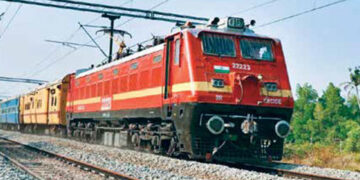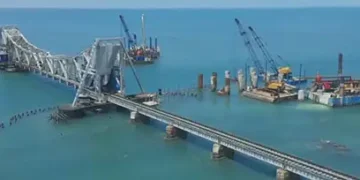Blitz Bureau
NEW DELHI: IN the mist-clad hills and deep valleys of India’s northeast, a revolution is unfolding on steel tracks. What was once considered a distant terrain is now being threaded together with ambitious railway projects signaling not just connectivity, but a new era of commerce, mobility, and integration for India’s northeast frontier.
Over the past decade, the northeast has seen its railway map redrawn at an unprecedented pace. Long-pending projects have moved from survey sheets to reality, with new stations opening in states that had none for over a century, and capitals finally being connected to the national network. Among them is Mizoram’s 51 km Bairabi–Sairang railway line, inaugurated by Prime Minister Narendra Modi, a milestone that has finally put Aizawl on India’s railway map.
From the bustling hub of Guwahati to the serene borders of Mizoram and Nagaland, new lines are stretching across mountains, tunnels, and rivers, promising to transform not just connectivity, but also the very rhythm of life.
Investment wave
Once dependent on a handful of isolated stations, the region now stands at the cusp of a railway renaissance. Since 2014, railway allocations to the region have multiplied five times, touching Rs 62,477 crore.
In Mizoram, Nagaland, Manipur, and beyond, long-delayed projects are finally linking capitals to the national grid. In Tripura, railway line has reached the borders, Meghalaya has seen its first railway station, while Arunachal Pradesh, Sikkim, and Assam push forward with new lines, electrification, and doubling works.
Prime Minister Narendra Modi inaugurated the 51 km Bairabi–Sairang line, built at a cost of over Rs 8,070 crore, finally bringing Aizawl’s grand debut onto the railway tracks.
Railway journey
Mizoram’s railway journey began in the late 1980s with Bairabi station near the Assam border, as a metre-gauge station in the late 1980s. In 2016, it was upgraded to broad gauge.
Looking ahead, the ongoing 223 km Sairang–Hbicchhuah project aims to extend tracks to Mizoram’s southern border, opening direct trade routes to Myanmar and Southeast Asia via Sittwe port.
Dimapur, opened in the early 20th century, remained Nagaland’s lone railhead for over 100 years. In 2022, Shokhuvi ended that isolation, becoming the state’s second station. The 82.5 km Dimapur–Kohima new line is progressing with Dhansiri–Shokhuvi section commissioned in October 2021 and the first passenger service rolling out in August 2022.
In Tripura, the 152 km Badarpur– Agartala line was converted to broad gauge in April 2016. The Agartala–Sabroom line (112 km) extended the railways till the southernmost part of Tripura, close to the Bangladesh border.
Gauge conversion
Jiribam station, close to the Assam border, was converted from metre gauge to broad gauge in March 2016 under the 49.61-km Arunachal–Jiribam project. The 110.625 km Jiribam–Imphal line is under progress.
Between 2014 and 2017, 833.42 km of metre-gauge tracks in the northeast, including 671.52 km in Assam, were converted to broad gauge.
In Arunachal Pradesh, Naharlagun station connecting Itanagar, was commissioned in April 2014 under the 21.75 km Harmuti–Naharlagun New Line Project. The Balipara–Bhalukpong line was converted to broad gauge in May 2015.
The 44.96 km Sevok–Rangpo line in Sikkim is under progress and targeted for completion by December 2027, providing the state’s first railway connectivity. Mendipathar became Meghalaya’s first railway station in 2014 under the 19.62 km Dudhnoi–Mendipathar project which contains 8.67 km of railway tracks inside Meghalaya.
Persistence, progress
The story of railways in the northeast is one of persistence and progress. In little more than a decade, the region has witnessed century-old metregauge lines upgraded, long-delayed projects revived, and capital cities like Aizawl and Imphal finally placed on the railway map.
Assam has emerged as the backbone with electrification and doubling, while frontier states like Mizoram, Nagaland, and Arunachal Pradesh push tracks toward borders and trade gateways. Tripura has reached the Bangladesh border, and Meghalaya and Sikkim await their turn. Together, these milestones mark more than engineering feats, they signal a northeast steadily moving from isolation to integration, with steel tracks carrying the promise of growth, connectivity, and new horizons.
































